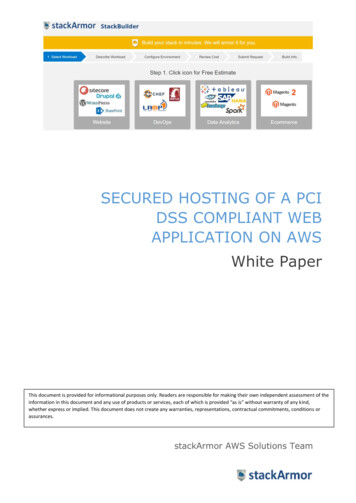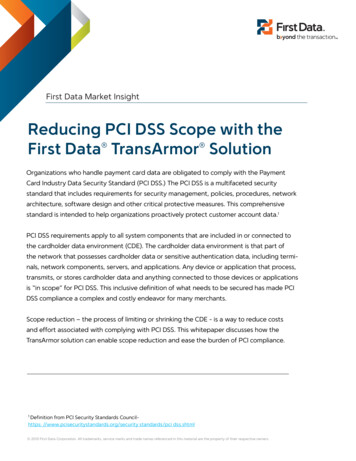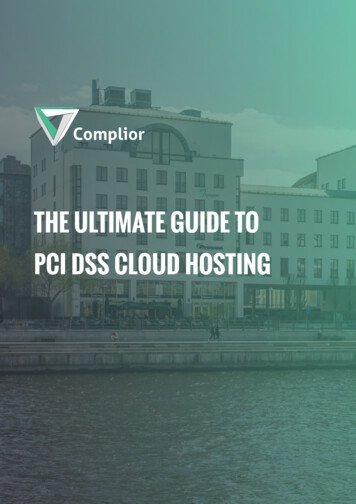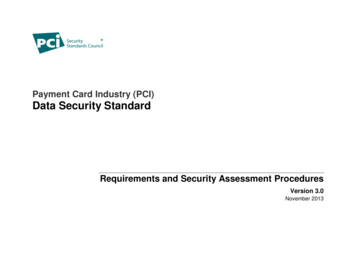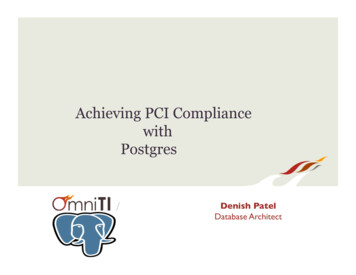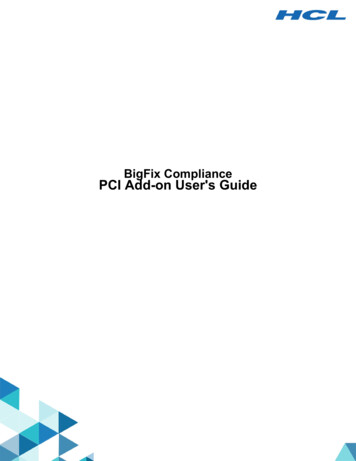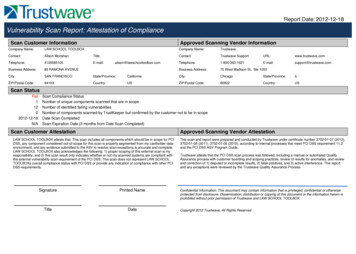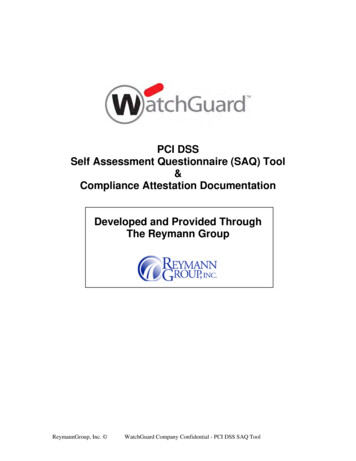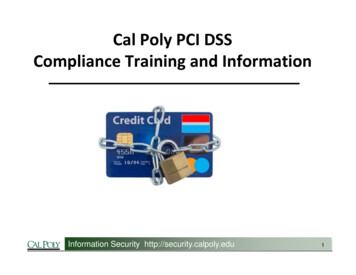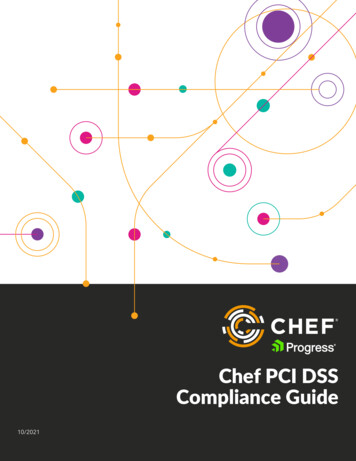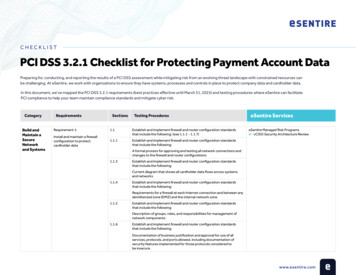
Transcription
CHECKLISTPCI DSS 3.2.1 Checklist for Protecting Payment Account DataPreparing for, conducting, and reporting the results of a PCI DSS assessment while mitigating risk from an evolving threat landscape with constrained resources canbe challenging. At eSentire, we work with organizations to ensure they have systems, processes and controls in place to protect company data and cardholder data.In this document, we’ve mapped the PCI DSS 3.2.1 requirements (best practices effective until March 31, 2025) and testing procedures where eSentire can facilitatePCI compliance to help your team maintain compliance standards and mitigate cyber risk.CategoryBuild andMaintain aSecureNetworkand SystemsRequirementsRequirement 1:Install and maintain a firewallconfiguration to protectcardholder dataSections1.11.1.11.1.31.1.41.1.51.1.6Testing ProceduresEstablish and implement firewall and router configuration standardsthat include the following: (see 1.1.1 - 1.1.7)Establish and implement firewall and router configuration standardsthat include the following:eSentire ServiceseSentire Managed Risk ProgramsvCISO Security Architecture ReviewA formal process for approving and testing all network connections andchanges to the firewall and router configurationsEstablish and implement firewall and router configuration standardsthat include the following:Current diagram that shows all cardholder data flows across systemsand networksEstablish and implement firewall and router configuration standardsthat include the following:Requirements for a firewall at each Internet connection and between anydemilitarized zone (DMZ) and the internal network zoneEstablish and implement firewall and router configuration standardsthat include the following:Description of groups, roles, and responsibilities for management ofnetwork componentsEstablish and implement firewall and router configuration standardsthat include the following:Documentation of business justification and approval for use of allservices, protocols, and ports allowed, including documentation ofsecurity features implemented for those protocols considered tobe insecure.www.esentire.com
CategoryBuild andMaintain aSecureNetworkand SystemsRequirementsRequirement 1:Install and maintain a firewallconfiguration to protectcardholder dataSections1.1.71.21.5Requirement 2:Do not use vendor-supplieddefaults for system passwordsand other security ataRequirement 3:Protect stored cardholder data3.1Testing ProcedureseSentire ServicesEstablish and implement firewall and router configuration standards thatinclude the following:Requirement to review firewall and router rule sets at least every six monthseSentire Managed Risk ProgramsvCISO Security Architecture ReviewEnsure that security policies and operational procedures for managingfirewalls are documented, in use, and known to all affected parties.eSentire Managed Risk ProgramsvCISO Security Policy Review & GuidanceImplement additional security features for any required services,protocols, or daemons that are considered to be insecure.Note: Where SSL/early TLS is used, the requirements in Appendix A2 must becompleted.eSentire Managed Detection and Response for:NetworkEndpointMaintain an inventory of system components that are in scope forPCI DSS.eSentire Managed Risk ProgramsvCISO Vendor Risk Management ProgramBuild firewall and router configurations that restrict connectionsbetween untrusted networks and any system components in thecardholder data environment.Note: An “untrusted network” is any network that is external to the networksbelonging to the entity under review, and/or which is out of the entity’s abilityto control or manage.Develop configuration standards for all system components. Assurethat these standards address all known security vulnerabilities and areconsistent with industry-accepted system hardening standards.Sources of industry-accepted system hardening standards may include,but are not limited to:- Center for Internet Security (CIS)- International Organization for Standardization (ISO)- SysAdmin Audit Network Security (SANS) Institute- National Institute of Standards Technology (NIST).Configure system security parameters to prevent misuse.Ensure that security policies and operational procedures for managingvendor defaults and other security parameters are documented, in use,and known to all affected parties.Shared hosting providers must protect each entity’s hosted environmentand cardholder data. These providers must meet specific requirements asdetailed in Appendix A1: Additional PCI DSS Requirements for Shared HostingProviders.Keep cardholder data storage to a minimum by implementing dataretention and disposal policies, procedures and processes that includeat least the following for all cardholder data (CHD) storage:eSentire Managed Risk ProgramsvCISO Security Architecture ReviewvCISO Security Policy Review & GuidanceeSentire Managed Detection and Response for:LogeSentire Managed Vulnerability and RiskvCISO Security Policy review & Guidance- L imiting data storage amount and retention time to that which isrequired for legal, regulatory, and/or business requirements- Specific retention requirements for cardholder data- Processes for secure deletion of data when no longer needed- A quarterly process for identifying and securely deleting storedcardholder data that exceeds defined retention.www.esentire.com
nt 4:Encrypt transmission ofcardholder data across open,public networksSections4.1Testing ProceduresUse strong cryptography and security protocols to safeguard sensitivecardholder data during transmission over open, public networks,including the following:- Only trusted keys and certificates are accepted.- The protocol in use only supports secure versions or configurations.- The encryption strength is appropriate for the encryption methodologyin use.eSentire ServiceseSentire Managed Detection and ResponseNote: Where SSL/early TLS is used, the requirements in Appendix A2must be completed.4.3Maintain aVulnerabilityManagementProgramRequirement 5:Protect all systems againstmalware and regularly updateanti-virus software or programs5.15.1.15.1.25.25.35.4Examples of open, public networks include but are not limited to:- The Internet- Wireless technologies, including 802.11 and Bluetooth- Cellular technologies, for example, Global System for Mobilecommunications (GSM), Code division multiple access (CDMA)- General Packet Radio Service (GPRS)- Satellite communicationsEnsure that security policies and operational procedures for encryptingtransmissions of cardholder data are documented, in use, and known toall affected parties.Deploy anti-virus software on all systems commonly affected bymalicious software (particularly personal computers and servers).Ensure that anti-virus programs are capable of detecting, removing,and protecting against all known types of malicious software.eSentire Managed Risk ProgramsvCISO Security Policy Review & GuidanceeSentire Managed Detection and Response for:EndpointFor systems considered to be not commonly affected by malicioussoftware, perform periodic evaluations to identify and evaluate evolvingmalware threats in order to confirm whether such systems continue tonot require anti-virus software.Ensure that all anti-virus mechanisms are maintained as follows:- Are kept current,- Perform periodic scans- Generate audit logs which are retained per PCI DSS Requirement 10.7.Ensure that anti-virus mechanisms are actively running and cannotbe disabled or altered by users, unless specifically authorized bymanagement on a case-by-case basis for a limited time period.Note: Anti-virus solutions may be temporarily disabled only if there islegitimate technical need, as authorized by management on a case-by-casebasis. If anti-virus protection needs to be disabled for a specific purpose, itmust be formally authorized. Additional security measures may also need tobe implemented for the period of time during which anti-virus protection isnot active.Ensure that security policies and operational procedures for protectingsystems against malware are documented, in use, and known to allaffected parties.eSentire Managed Risk ProgramsvCISO Security Policy Review & Guidancewww.esentire.com
CategoryMaintain ment 6:Develop and maintain securesystems and applicationsSections6.1Testing ProceduresEstablish a process to identify security vulnerabilities, using reputableoutside sources for security vulnerability information, and assign a riskranking (for example, as “high,” “medium,” or “low”) to newly discoveredsecurity vulnerabilities.Note: Risk rankings should be based on industry best practices as well asconsideration of potential impact. For example, criteria for ranking vulnerabilities may include consideration of the CVSS base score, and/or theclassification by the vendor, and/or type of systems affected.6.26.36.3.16.4.6eSentire ServiceseSentire Managed Risk ProgramsvCISO Vulnerability Management ProgramInternal Vulnerability ScanExternal Vulnerability ScanManaged Vulnerability Service - Cloud, Co-ManagedMethods for evaluating vulnerabilities and assigning risk ratings will varybased on an organization’s environment and risk- assessment strategy. Riskrankings should, at a minimum, identify all vulnerabilities considered to be a“high risk” to the environment. In addition to the risk ranking, vulnerabilitiesmay be considered “critical” if they pose an imminent threat to the environment, impact critical systems, and/or would result in a potential compromiseif not addressed. Examples of critical systems may include security systems,public-facing devices and systems, databases, and other systems that store,process, or transmit cardholder data.Ensure that all system components and software are protected fromknown vulnerabilities by installing applicable vendor- supplied securitypatches. Install critical security patches within one month of release.Note: Critical security patches should be identified according to the riskranking process defined in Requirement 6.1.Develop internal and external software applications (including web-basedadministrative access to applications) securely, as follows:- In accordance with PCI DSS (for example, secure authenticationand logging)- Based on industry standards and/or best practices.- Incorporating information security throughout thesoftware-development life cycleeSentire Managed Risk ProgramsWeb Application Vulnerability AssessmenteSentire Managed Detection and Response for:LogNote: this applies to all software developed internally as well as bespoke orcustom software developed by a third party.Remove development, test and/or custom application accounts, user IDs,and passwords before applications become active or are releasedto customers.Follow change control processes and procedures for all changes tosystem components. The processes must include the following:Upon completion of a significant change, all relevant PCI DSSrequirements must be implemented on all new or changed systems andnetworks, and documentation updated as applicable.eSentire Managed Risk ProgramsInternal Vulnerability ScanExternal Vulnerability ScanNote: This requirement is a best practice until January 31, 2018, after whichit becomes a requirement.www.esentire.com
CategoryMaintain ment 6:Develop and maintain securesystems and applicationsSections6.5Note: Requirements 6.5.1 through6.5.6, below, apply to allapplications (internal or external).Note: Requirements 6.5.7 through6.5.10 apply to web applicationsand application interfaces (internalor Testing ProceduresAddress common coding vulnerabilities in software-developmentprocesses as follows (see 6.5.1 - 6.5.10):- Train developers at least annually in up- to-date secure codingtechniques, including how to avoid common coding vulnerabilities.- Develop applications based on secure coding guidelines.Note: The vulnerabilities listed at 6.5.1 through 6.5.10 were current with industry best practices when this version of PCI DSS was published. However,as industry best practices for vulnerability management are updated (forexample, the OWASP Guide, SANS CWE Top 25, CERT Secure Coding, etc.),the current best practices must be used for these requirements.eSentire ServiceseSentire Managed Risk ProgramsInternal testingExternal testingRed Team ExerciseWeb Application Vulnerability AssessmentAddress common coding vulnerabilities in software-developmentprocesses as follows:Injection flaws, particularly SQL injection. Also consider OS CommandInjection, LDAP and XPath injection flaws as well as other injection flaws.Address common coding vulnerabilities in software-developmentprocesses as follows:Buffer overflowsAddress common coding vulnerabilities in software-developmentprocesses as follows:Insecure cryptographic storageAddress common coding vulnerabilities in software-developmentprocesses as follows:Insecure communicationsAddress common coding vulnerabilities in software-developmentprocesses as follows:Improper error handlingAddress common coding vulnerabilities in software-developmentprocesses as follows:All “high risk” vulnerabilities identified in the vulnerability identificationprocess (as defined in PCI DSS Requirement 6.1).Address common coding vulnerabilities in software-developmentprocesses as follows:Cross-site scripting (XSS)Address common coding vulnerabilities in software-developmentprocesses as follows:Improper access control (such as insecure direct object references,failure to restrict URL access, directory traversal, and failure to restrictuser access to functions).www.esentire.com
CategoryMaintain ment 6:Develop and maintain securesystems and applicationsNote: Requirements 6.5.7 through6.5.10 apply to web applicationsand application interfaces (internalor external).Sections6.5.96.5.106.6Testing ProceduresAddress common coding vulnerabilities in software-developmentprocesses as follows:Cross-site request forgery (CSRF)Address common coding vulnerabilities in software-developmentprocesses as follows:eSentire ServiceseSentire Managed Risk ProgramsInternal testingExternal testingRed Team ExerciseWeb Application Vulnerability AssessmentBroken authentication and session management.For public-facing web applications, address new threats andvulnerabilities on an ongoing basis and ensure these applications areprotected against known attacks by either of the following methods:- Reviewing public-facing web applications via manual or automatedapplication vulnerability security assessment tools or methods, atleast annually and after any changesNote: This assessment is not the same as the vulnerability scansperformed for Requirement 11.2.6.7ImplementStrong AccessControlMeasuresRequirement 7:7.3Requirement 8:8.1.5Restrict access to cardholderdata by business need to knowIdentify and authenticate accessto system components- Installing an automated technical solution that detects and preventsweb- based attacks (for example, a web- application firewall) in frontof public- facing web applications, to continually check all traffic.Ensure that security policies and operational procedures for developingand maintaining secure systems and applications are documented,in use, and known to all affected parties.eSentire Managed Risk ProgramsvCISO Security Policy Review & GuidanceDefine and implement policies and procedures to ensure proper useridentification management for non- consumer users and administratorson all system components as follows:eSentire Managed Detection and Response for:LogEnsure that security policies and operational procedures forrestricting access tocardholder data are documented, in use, andknown to all affected parties.Manage IDs used by third parties to access, support, or maintain systemcomponents via remote access as follows:8.48.8- Enabled only during the time period needed and disabled when notin use.- Monitored when in use.Document and communicate authentication policies and procedures toall users including:- Guidance on selecting strong authentication credentials- Guidance for how users should protect their authenticationcredentials- Instructions not to reuse previously used passwords- Instructions to change passwords if there is any suspicion thepassword could be compromised.eSentire Managed Risk ProgramsvCISO Security Policy Review & GuidanceEnsure that security policies and operational procedures foridentification and authentication are documented, in use, and knownto all affected parties.www.esentire.com
CategoryRegularlyMonitor andTest NetworksRequirementsRequirement 10:Track and monitor all accessto network resources andcardholder 10.2.610.2.710.310.3.110.3.210.3.3Testing ProceduresImplement audit trails to link all access to system components to eachindividual user.Implement automated audit trails for all system components toreconstruct the following events: (see 10.2.1 - 10.2.7)eSentire ServiceseSentire Managed Detection and Response for:LogImplement automated audit trails for all system components toreconstruct the following events:All individual user accesses to cardholder dataImplement automated audit trails for all system components toreconstruct the following events:All actions taken by any individual with root or administrative privilegesImplement automated audit trails for all system components toreconstruct the following events:Access to all audit trailsImplement automated audit trails for all system components toreconstruct the following events:Invalid logical access attemptsImplement automated audit trails for all system components toreconstruct the following events:Use of and changes to identification and authentication mechanisms—including but not limited to creation of new accounts and elevation ofprivileges—and all changes, additions, or deletions to accounts with rootor administrative privilegesImplement automated audit trails for all system components toreconstruct the following events:Initialization, stopping, or pausing of the audit logsImplement automated audit trails for all system components toreconstruct the following events:Creation and deletion of system- level objectsRecord at least the following audit trail entries for all systemcomponents for each event: (see 10.3.1 - 10.3.6)Record at least the following audit trail entries for all systemcomponents for each event:User identificationRecord at least the following audit trail entries for all systemcomponents for each event:Type of eventRecord at least the following audit trail entries for all systemcomponents for each event:Date and timewww.esentire.com
CategoryRegularlyMonitor andTest NetworksRequirementsRequirement 10:Track and monitor all accessto network resources andcardholder dataSections10.3.410.3.510.3.610.5Testing ProceduresRecord at least the following audit trail entries for all systemcomponents for each event:Success or failure indicationOrigination of eventRecord at least the following audit trail entries for all systemcomponents for each event:Identity or name of affected data, system component, or resource.Secure audit trails so they cannot be altered.Limit viewing of audit trails to those with a job-related need.10.5.2Protect audit trail files from unauthorized modifications.10.5.3Promptly back up audit trail files to a centralized log server or mediathat is difficult to alter.10.610.6.110.6.210.6.310.7eSentire Managed Detection and Response for:LogRecord at least the following audit trail entries for all systemcomponents for each event:10.5.110.5.4eSentire ServicesWrite logs for external-facing technologies onto a secure, centralized,internal log server or media device.Review logs and security events for all system components to identifyanomalies or suspicious activity.Note: Log harvesting, parsing, and alerting tools may be used to meet thisRequirement.Review the following at least daily:- All security events- Logs of all system components that store, process, or transmitCHD and/or SAD- Logs of all critical system components- Logs of all servers and system components that perform securityfunctions (for example, firewalls, intrusion-detection systems/intrusion-prevention systems (IDS/IPS), authentication servers,e-commerce redirection servers, etc.).Review logs of all other system components periodically based on theorganization’s policies and risk management strategy, as determined bythe organization’s annual risk assessment.Follow up exceptions and anomalies identified during the review process.Retain audit trail history for at least one year, with a minimum of threemonths immediately available for analysis (for example, online, archived,or restorable from backup).www.esentire.com
CategoryRegularlyMonitor andTest NetworksRequirementsRequirement 10:Track and monitor all accessto network resources andcardholder dataSections10.810.8.1Testing ProceduresAdditional requirement for service providers only: Implement a processfor the timely detection and reporting of failures of critical securitycontrol systems, including but not limited to failure of:- Firewalls- IDS/IPS- FIM- Anti-virus- Physical access controls- Logical access controls- Audit logging mechanisms- Segmentation controls (if used)eSentire ServiceseSentire Managed Detection and ResponseNote: This requirement is a best practice until January 31, 2018, after whichit becomes a requirement.Additional requirement for service providers only: Respond to failures ofany critical security controls in a timely manner. Processes for respondingto failures in security controls must include:- Restoring security functions- Identifying and documenting the duration (date and time start to end)of the security failure- Identifying and documenting cause(s) of failure, including root cause,and documenting remediation required to address root cause- Identifying and addressing any security issues that arose duringthe failure- Performing a risk assessment to determine whether further actionsare required as a result of the security failure- Implementing controls to prevent cause of failure from reoccurring- Resuming monitoring of security controls10.9Requirement 11:Regularly test security systemsand processes.11.1Note: This requirement is a best practice until January 31, 2018, after whichit becomes a requirement.Ensure that security policies and operational procedures for monitoringall access to network resources and cardholder data are documented, inuse, and known to all affected parties.Implement processes to test for the presence of wireless access points(802.11), and detect and identify all authorized and unauthorized wirelessaccess points on a quarterly basis.Note: Methods that may be used in the process include but are notlimited to wireless network scans, physical/logical inspections ofsystem components and infrastructure, network access control (NAC),or wireless IDS/IPS.11.1.2Whichever methods are used, they must be sufficient to detect andidentify both authorized and unauthorized devices.Implement incident response procedures in the event unauthorizedwireless access points are detected.eSentire Managed Risk ProgramsvCISO Security Policy Review & GuidanceeSentire Managed Risk ProgramsInternal testingExternal testingeSentire Managed Risk ProgramsvCISO Security Incident Response Planningwww.esentire.com
CategoryRegularlyMonitor andTest NetworksRequirementsRequirement 11:Regularly test security systemsand processes.Sections11.2Testing ProceduresRun internal and external network vulnerability scans at least quarterlyand after any significant change in the network (such as new systemcomponent installations, changes in network topology, firewall rulemodifications, product upgrades).Note: Multiple scan reports can be combined for the quarterly scan processto show that all systems were scanned and all applicable vulnerabilitieshave been addressed. Additional documentation may be required to verifynon-remediated vulnerabilities are in the process of being addressed.11.2.111.2.2eSentire ServiceseSentire Managed Risk ProgramsvCISO Vulnerability Management ProgramInternal Vulnerability ScanExternal Vulnerability ScanFor initial PCI DSS compliance, it is not required that four quarters of passingscans be completed if the assessor verifies 1) the most recent scan resultwas a passing scan, 2) the entity has documented policies and proceduresrequiring quarterly scanning, and 3) vulnerabilities noted in the scan resultshave been corrected as shown in a re-scan(s). For subsequent years after theinitial PCI DSS review, four quarters of passing scans must have occurred.Perform quarterly internal vulnerability scans. Address vulnerabilitiesand perform rescans to verify all “high risk” vulnerabilities are resolved inaccordance with the entity’s vulnerability ranking (per Requirement 6.1).Scans must be performed by qualified personnel.Perform quarterly external vulnerability scans, via an Approved ScanningVendor (ASV) approved by the Payment Card Industry Security StandardsCouncil (PCI SSC). Perform rescans as needed, until passing scans areachieved.Note: Quarterly external vulnerability scans must be performed by anApproved Scanning Vendor (ASV), approved by the Payment CardIndustry Security Standards Council (PCI SSC).11.2.311.3Refer to the ASV Program Guide published on the PCI SSC website for scancustomer responsibilities, scan preparation, etc.Perform internal and external scans, and rescans as needed, after anysignificant change. Scans must be performed by qualified personnel.Implement a methodology for penetration testing that includes thefollowing:- Is based on industry-accepted penetration testing approaches(for example, NIST SP800-115)- Includes coverage for the entire CDE perimeter and critical systems- Includes testing from both inside and outside the network- Includes testing to validate any segmentation and scope-reductioncontrols- Defines application-layer penetration tests to include, at a minimum,the vulnerabilities listed in Requirement 6.5- Defines network-layer penetration tests to include components thatsupport network functions as well as operating systems- Includes review and consideration of threats and vulnerabilitiesexperienced in the last 12 months- Specifies retention of penetration testing results and remediationactivities results.eSentire Managed Risk ProgramsInternal Vulnerability ScanExternal Vulnerability ScanRed Team Exercisewww.esentire.com
CategoryRegularlyMonitor andTest NetworksRequirementsRequirement 11:Regularly test security systemsand .6Maintain anInformationSecurity PolicyRequirement 12:Maintain a policy thataddresses information securityfor all personnel.12.112.1.112.2Testing ProceduresPerform external penetration testing at least annually and after anysignificant infrastructure or application upgrade or modification (such asan operating system upgrade, a sub-network added to the environment,or a web server added to the environment).Perform internal penetration testing at least annually and after anysignificant infrastructure or application upgrade or modification (such asan operating system upgrade, a sub-network added to the environment,or a web server added to the environment).eSentire ServiceseSentire Managed Risk ProgramsInternal Vulnerability ScanExternal Vulnerability ScanRed Team ExerciseIf segmentation is used to isolate the CDE from other networks,perform penetration tests at least annually and after any changes tosegmentation controls/methods to verify that the segmentationmethods are operational and effective, and isolate all out-of-scopesystems from systems in the CDE.Additional requirement for service providers only: If segmentation isused, confirm PCI DSS scope by performing penetration testing onsegmentation controls at least every six months and after any changesto segmentation controls/methods.Note: This requirement is a best practice until January 31, 2018, after whichit becomes a requirement.Use intrusion-detection and/or intrusion-prevention techniques todetect and/or prevent intrusions into the network. Monitor all traffic atthe perimeter of the cardholder data environment as well as at criticalpoints in the cardholder data environment, and alert personnel tosuspected compromises.eSentire Managed Detection and Response for:NetworkEndpointLogEnsure that security policies and operational procedures for securitymonitoring and testing are documented, in use, and known to allaffected parties.eSentire Managed Risk ProgramsvCISO Security Policy Review & GuidanceKeep all intrusion-detection and prevention engines, baselines, andsignatures up to date.Establish, publish, maintain, and disseminate a security policy.Review the security policy at least annually and update the policy whenthe environment changes.Implement a risk-assessment process that:- Is performed at least annually and upon significant changes to theenvironment (for example, acquisition, merger, relocation, etc.),- Identifies critical assets, threats, and vulnerabilities, and- Results in a formal, documented analysis of risk.eSentire Managed Risk ProgramsvCISO Security Policy Review & GuidancevCISO Security Incident Response PlanningeSentire Managed Risk ProgramsvCISO Security Program Maturity AssessmentExamples of risk-assessment methodologies include but are not limited toOCTAVE, ISO 27005 and NIST SP 800-30.www.esentire.com
CategoryMaintain anInformationSecurity PolicyRequirementsRequirement 12:Maintain a policy thataddresses information securityfor all personnel.Sections12.312.3.1Testing ProceduresDevelop usage policies for critical technologies and define proper use ofthese technolog
Install and maintain a firewall configuration to protect 1.1.7 Establish and implement firewall and router configuration standards that include the following: Requirement to review firewall and router rule sets at least every six months eSentire Managed Risk Programs 1.2 Build firewall and router configurations that restrict connections
